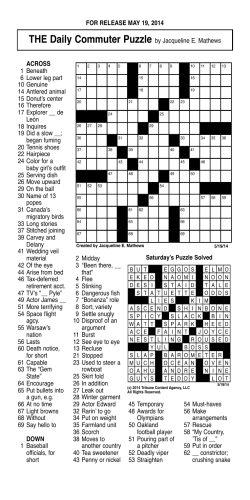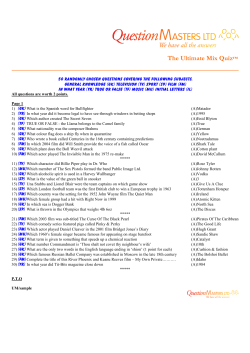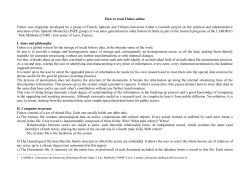
Network Matrix and Graph
Network Matrix and Graph Network Size Network size – a number of actors (nodes) in a network, usually denoted as k or n •Size is critical for the structure of social relations due to limited capacity of a single actor for maintaining ties •In smaller networks, actors are very likely to be connected to each other, while in larger networks connecting to everyone else becomes increasingly difficult •For directed (asymmetric) network, the number of possible ties is k*(k-1), for undirected (symmetric) it is k*(k-1)/2 •The number of possible relationships grows exponentially as the number of actors increases linearly and so does network complexity Network size=3 N of all possible ties=6 Network size=6 N of all possible ties = 30 Network size=6 N of all possible ties = 30 Network Density Density - proportion of all possible ties that are actually present • Sum of existing ties divided by the number of all possible ties a1 a2 a1 1 a3 a4 a5 a6 sum 1 1 1 1 5 1 1 0 0 3 1 0 0 3 0 0 3 1 2 a2 1 a3 1 1 a4 1 1 1 a5 1 0 0 0 a6 1 0 0 0 1 Density=18/(6*5)=18/30=.6 In UCINET: Network Cohesion Density Density Overall 2 18 Network Density Density informs about the speed at which information or resources diffuse among the nodes and the extent to which actors have high levels of social capital and/or social constraint Density=.6 Density=1.0 Components Component – a part of a network that is connected within, but disconnected from other parts of a network Isolate – a single actor disconnected from the rest of the network Disconnected components mean that network consists of separate subpopulations with no flow of information, resources, influence, etc. between them For directed graphs, there are two types of components: 1) a weak component is a set of nodes that are connected, regardless of the direction of ties 1) a strong component requires that there be a directed path from A to B in order for the two to be in the same component Three components (1,2,3,4), (5,6,7,8),(9) One isolate (9). In UCINET for binary data: Network Regions Components Simple graphs (For valued graphs: Network Regions Components Valued graphs ) Reachability Reachability tells us whether two actors are connected or not by way of either a direct or an indirect pathways of any length •If some actors in a network cannot reach others: – there is the potential for disruption of the flow of information and resources – this may indicate that the population we are studying is really composed of more than one sub-populations In UCINET: Network Cohesion Reachability a1 is reachable only from a4,a6 a2 is reachable only from a1, a4 and a6 a6 is unreachable to the nodes in the larger component. Everyone in the connected component is reachable to each other. Geodesic Distance A walk is a sequence of actors and relations that begins and ends with actors Geodesic distance - the number of relations in the shortest possible walk from one actor to another • The geodesic path (or paths, as there can be more than one) is often the "optimal" or most "efficient" connection between two actors Diameter - the largest geodesic distance in the (connected) network In UCINET: Network Cohesion Geodesic Distances Geodesic Distances 123456 aaaaaa - - - -- 1 a1 0 1 2 1 x 1 5 2 a2 x 0 x x x x 0 3 a3 x x 0 x x x 0 4 a4 2 3 1 0 x 1 7 5 a5 x x x 1 0 x 1 6 a6 1 2 1 2 x 0 6 SUM 19 (x means no path) Diameter is 3 The geodesic distance from a1to a2=1, from a1 to a3=2, from a1 to a4=1, from a1 to a6=1 and there is no geodesic distance from a1 to a5. The average geodesic among reachable pairs is (19/13=)1.462. Blocks, Cutpoints, and Bridges Cut-point - a node, removal of which would break up a network into disconnected parts Blocks – parts into which cut-points divide a network Bridge – a tie between two nodes, removal of which would break up a network into disconnected parts Cut-points may act as brokers among otherwise disconnected groups Cut-points and bridges are network’s weak spots vulnerable to disruptions in the flow of information, resources, and influence No cut-points, no bridges a1 is a cut-point, no bridges Two blocks: (a5, a6) and (a2, a3, a4) 1 and 2 are cut-points a tie Tie between 1 and 2 is a bridge In UCINET for binary data: Network Regions Bi-components Centrality • Look at the positions of actor A in these three networks • In which network does actor A have more favorable and less favorable position? • Actor D? • How equally is centrality distributed in these networks? “Line” network "Star” network “Circle” network Degree Centrality • More choices/alternatives means more opportunities and less dependence/constraint • The more ties actor have, the more power they may have • Degree centrality is the number of connections an actor (node) has • When ties are directed, we calculate total number of ties sent (out-degree) and ties received (in-degree) • Out-degree typically indicates influence, in-degree indicates prestige or popularity In UCINET: Network Centrality and Power Degree Select whether to treat data as symmetric or not. A has 6 connections, B,C, D, E, F, G have 1 connection A B,C, D, E, F, G have 2 connections Closeness Centrality • • • • • • • • Degree centrality does not take into account indirect ties an actor has Closeness centrality emphasizes the distance of an actor to all others in the network The closer one is to others in the network, the more favored is that actor’s position Farness is the sum of the geodesic distances from each ego to all others in the network “Closeness" is the reciprocal of farness = 1/farness “nCloseness” is Closeness times the number of alters Degree centrality measures one’s local position, while closeness centrality measures position globally Closeness is indefinite for disconnected nodes Closeness is meaningful only for a connected network In UCINET: Network Centrality and Power Closeness (old) Select whether to treat data as symmetric or not. Interpret results cautiously if a network is disconnected. Farness: A gets in 1 step to each of the other 6, 6*1=6 The rest get to A in 1 step and to the other 5 in 2, 1+5*2=11 Closeness: A (1/6)=.167 nCloseness: A 100*(7-1)*1/6=100 The rest 100*(7-1)*1/11=54.545. Farness: 2*1+2*2+2*3=12 Closeness: 1/12=.08 nCloseness: 100*(7-1)*1/12=50 Betweenness Centrality • The more people depend on an actor to make connections with others, the more power that actor has • Betweenness centrality is the extent to which an actor falls on the geodesic paths between other pairs of actors in the network All of them are on 3 geodesic paths. E.g. A is between B&G, B&F and C&G. A is in all geodesic paths between any pair of the others. There are 6 others and 6*5/2=15 ways you can get from any of the 6 to any of the other 5, so for A=15. For the rest 0. In UCINET: Network Centrality and Power Freeman Betweenness Node Betweenness Centrality vs. Centralization • Centrality is a characteristic of an actor’s position in a network • Centralization is a characteristic of a network • Centralization indicates: – how unequal the distribution of centrality is in a network or – how much variance there is in the distribution of centrality in a network • Centrality is a micro-level measure • Centralization is a macro-level measure – There are as many centralization measures as centrality measures • To find centralization, – a. you must find the most central actor C* – b. take its centrality score and subtract the centrality score of each of the others, Ci, from it – c. add up the differences: Σ(C*-Ci) – d. then divide this by what this sum would be under the largest possible centralization (if the network was a star) : Max Σ(C*-Ci) – e. multiply this by 100 to turn it into a percentage • Centralization= 100* Σ(C*-Ci) / Max Σ(C*-Ci) Centralization (symmetric matrices) • • Note: all three networks are symmetric Star: 100%, Circle: 0% on all measures of centralization. • Degree Centralization • • • • For the third network: The most central actor is a1 Σ(C*-Ci)=(5-3)+(5-3)+(5-3)+(5-2)+(5-2)=2+2+2+3+3=12 Max. centralization: one actor has 5 ties, all the rest have 1. For symmetric matrices: – • • Max. Degree Centralization=(N-1)*N-2) Max Σ(C*-Ci)=(5-1)+(5-1)+(5-1)+(5-1)+(5-1)=5*4=20 Centralization=100*12/20=60 or 60% 1 • • • • • • • • • 2 3 Degree NrmDegree Share ------------ ----------- -----------1 a1 (C*) 5.000 100.000 0.278 2 a2 3.000 60.000 0.167 3 a3 3.000 60.000 0.167 4 a4 3.000 60.000 0.167 5 a5 2.000 40.000 0.111 6 a6 2.000 40.000 0.111 Network Centralization = 60.00% • In UCINET: Network Centrality and Power Degree Select whether to treat data as symmetric or not. Centralization (symmetric matrices) • Closeness Centralization • • • • • • The most central actor is a1. – Σ(C*-Ci)=(100-71.429)+(100-71.429)+(100-71.429)+(10062.5)+(100-62.5)=3*28.571+2*37.5=160.713 Max. centralization: one actor gets to all others in one step: – sum of geodesic distance or farness=(n-1)*1, – nCloseness=100*(n-1)*1/(n-1)*1=100, all the others will get to central actor in one step and everyone else in 2 steps: – sum of geodesic distance or farness=1+2(n-2), – nCloseness=100*(n-1)*1/(1+2(n-2))=100*5/9=55.55556 Max Σ(C*-Ci)= (100-55.5556)+(100-55.5556)+(100-55.5556)+(10055.5556)+(100-55.5556)=5*44.4444=222.2222 Centralization=100*160.713/222.2222=72.32 or 72.32% • 1 2 • • • • • • • • Farness nCloseness ----------------------1 a1 (C*) 5.000 100.000 2 a2 7.000 71.429 3 a3 7.000 71.429 4 a4 7.000 71.429 5 a5 8.000 62.500 6 a6 8.000 62.500 • Network Centralization = 72.32% In UCINET: Network Centrality and Power Closeness (old) Select whether to treat data as symmetric or not. Centralization (symmetric matrices) • Betweenness centralization • • • • • • The most central actor is a1. – Σ(C*-Ci)=(6-0)+(6-0)+(6-0)+(6-0)+(6-0)=5*6=30 Max. centralization: one actor gets in between all the others, no matter how you pair them: – The others can be paired in (n-1)*(n-2)/2 ways so the central actor will get a score of (6-1)*(6-2)/2=10 The others are not between any pair of actors Max Σ(C*-Ci)= (10-0)+(10-0)+(10-0)+(10-0)+(10-0)=50 Centralization=100*30/50=60 or 60% • (It is a coincidence that Degree and Betweenness Centralization takes the same value in this particular case.) • • • • • • • • • 1 2 Betweenness nBetweenness ------------ -----------1 a1 (C*) 6 60 2 a2 0 0 3 a3 0 0 4 a4 0 0 5 a5 0 0 6 a6 0 0 • Network Centralization Index = 60.00% In UCINET: Network Centrality and Power Freeman Betweenness Node Betweenness Centralization symmetric vs. asymmetric matrices • • The same matrix will give different centralization scores depending on whether it is analyzed as symmetric or asymmetric. Asymmetric matrices will have an Indegree and an Outdegree measure of centralization. Take the Star matrix. As a symmetric matrix, it has a maximum centralization score (100%). But if we analyze it as a matrix of asymmetric relationships that just happen to show a symmetric pattern it is less centralized. Take Degree Centralization in a Star matrix where the asymmetric relationships happen to be symmetrical: • OutDegree • • • • • • • • InDegree NrmOutDeg NrmInDeg ------------ ------------ ------------ -----------1A 6.000 6.000 100.000 100.000 2B 1.000 1.000 16.667 16.667 3C 1.000 1.000 16.667 16.667 4D 1.000 1.000 16.667 16.667 5E 1.000 1.000 16.667 16.667 6F 1.000 1.000 16.667 16.667 7G 1.000 1.000 16.667 16.667 • • Network Centralization (Outdegree) = 83.333% Network Centralization (Indegree) = 83.333% • Now, centralization is not 100%. It is because the Maximum Centralization is different. In this case, the Max. Centralization (Outdegree) occurs when only one actor (A) has out-ties and none of the others do. (The same goes for Indegree centralization: it reaches maximum when only one actor has in-ties and none of the others do.) • 100*(6*(6-1))/6*(6-0)=100*30/36=83.333 • If only A has out-ties then it will have no in-ties. In that case, the Max. Indegree Centralization would be close to zero as 6 out of 7 actors (B—G) would have exactly the same number of in-ties (1 coming from A) and A would have none (0). • • Outdegree 100*(6*(6-0)/6*(6-0)=100 Indegree 100*(5*(1-1)+(1-0))/6*(6-0)=100*1/36= 2.778%
© Copyright 2025









